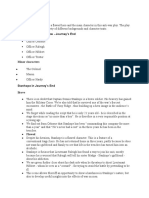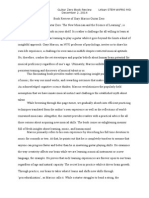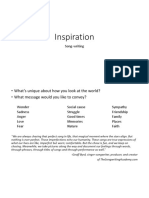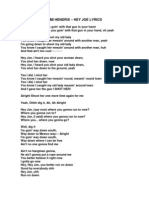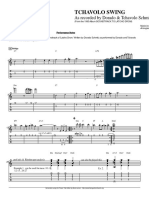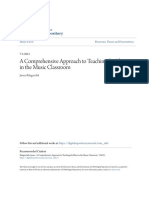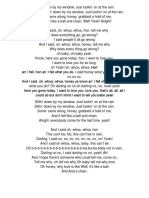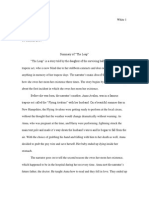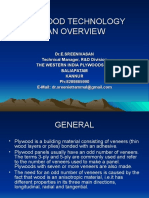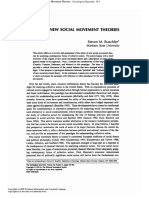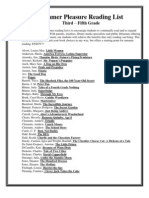0 ratings0% found this document useful (0 votes)
184 viewsJeff Buckley Grace Analisys GHFR
Jeff Buckley Grace Analisys GHFR
Uploaded by
TDROCKThe document provides an in-depth analysis of the song "Grace" by Jeff Buckley. It discusses the context of the album and song, the complex musical structure featuring verses and choruses, the discordant harmony and tonality including chromatic chords and key changes. It also examines the melody, guitar techniques, rhythm, meter, tempo, instrumentation including vocals, guitar, bass, drums, and strings. The analysis concludes with a sample exam question about the bassline in an extract of the song.
Copyright:
© All Rights Reserved
Available Formats
Download as RTF, PDF, TXT or read online from Scribd
Jeff Buckley Grace Analisys GHFR
Jeff Buckley Grace Analisys GHFR
Uploaded by
TDROCK0 ratings0% found this document useful (0 votes)
184 views5 pagesThe document provides an in-depth analysis of the song "Grace" by Jeff Buckley. It discusses the context of the album and song, the complex musical structure featuring verses and choruses, the discordant harmony and tonality including chromatic chords and key changes. It also examines the melody, guitar techniques, rhythm, meter, tempo, instrumentation including vocals, guitar, bass, drums, and strings. The analysis concludes with a sample exam question about the bassline in an extract of the song.
Original Description:
ghhbvhtv
Original Title
Jeff Buckley Grace Analisys ghfr
Copyright
© © All Rights Reserved
Available Formats
RTF, PDF, TXT or read online from Scribd
Share this document
Did you find this document useful?
Is this content inappropriate?
The document provides an in-depth analysis of the song "Grace" by Jeff Buckley. It discusses the context of the album and song, the complex musical structure featuring verses and choruses, the discordant harmony and tonality including chromatic chords and key changes. It also examines the melody, guitar techniques, rhythm, meter, tempo, instrumentation including vocals, guitar, bass, drums, and strings. The analysis concludes with a sample exam question about the bassline in an extract of the song.
Copyright:
© All Rights Reserved
Available Formats
Download as RTF, PDF, TXT or read online from Scribd
Download as rtf, pdf, or txt
0 ratings0% found this document useful (0 votes)
184 views5 pagesJeff Buckley Grace Analisys GHFR
Jeff Buckley Grace Analisys GHFR
Uploaded by
TDROCKThe document provides an in-depth analysis of the song "Grace" by Jeff Buckley. It discusses the context of the album and song, the complex musical structure featuring verses and choruses, the discordant harmony and tonality including chromatic chords and key changes. It also examines the melody, guitar techniques, rhythm, meter, tempo, instrumentation including vocals, guitar, bass, drums, and strings. The analysis concludes with a sample exam question about the bassline in an extract of the song.
Copyright:
© All Rights Reserved
Available Formats
Download as RTF, PDF, TXT or read online from Scribd
Download as rtf, pdf, or txt
You are on page 1of 5
At a glance
Powered by AI
The passage provides an in-depth analysis of the musical elements in Grace, including its structure, harmony, melody, instrumentation, and techniques used.
Techniques like chromatic chord progressions, key changes, distortion, flanger, and delay are discussed.
The structure is described as complex with verses, pre-choruses, choruses of varying lengths. The harmony is discordant with unusual chords and chromatic movements that create a sense of dissonance.
GCSE Music: Grace
By Gordon Yam (Notes Contributor)
Its time to dig into one of my favourite pieces of the GCSE
anthology Grace! Lets begin by outlining the general context:
Grace comes from the album Grace, sung by Jeff
Buckley
Other tracks from the album include Hallelujah and Last
Goodbye
The album is released in 1994
It is a rock ballad, or folk rock (Folk music is traditional
music of a country that is often learned and performed by
ear, passing down the music through the generations)
STRUCTURE
The structure of Grace is rather complex, though
generally a verse and chorus pattern is used throughout
the song. Before each verse, an instrumental section of
the introduction is included to lead the music.
The verses and pre-choruses are 14 bars long, where the
choruses have flexible lengths in different parts of the
song. All of the instrumental intros are 14 bars long.
After the second chorus, the song progresses to a 22 bars
bridge where the climax is built. It then plunges back into
the instrumental intro, followed by an altered section of
the original verses. The song finishes with repetitions of
Buckleys improvisation based on a chromatically falling
chord pattern.
HARMONY AND TONALITY
The harmony of the song is quite discordant and complex,
as Buckley experiments on different chord patterns. The
song contains multiple key changes and unusual chords,
particularly towards the end of the song in the choruses
and bridge.
Ascending pattern of minor chords is used in the
introduction, creating a slight confusion in the key of the
song. The key of E minor cannot be confirmed until the
first verse.
A lot of chromatic movement is used in the chord pattern
throughout the song, and this is comparatively unusual
for pop and rock music. One example of chromatic chords
is the verse, with the pattern Em F Em Eb.
Quite often there is a blend of two chords at the same
time, creating a deliberate sense of dissonance. The
chromatic scales and semitone progressions in the
harmony makes a polytonal effect throughout the song.
MELODY
The instrumental sections are mostly based on chord
accompaniment, other than the guitar riffs that play a
melody in the introductions.
In the verses, the vocal melody moves largely in steps
and sequences, beginning in a relatively lower vocal
range. Buckleys voice moves to a higher range in the prechorus, and continues to ascend throughout the song. The
bridge incorporates his use of high falsetto range.
Grace is based on the key of E minor, though Buckley
was extremely experimental in blending different modes
and scale systems together. The pre-chorus is written in E
minor mode, with the Dorian mode present in times (E
F# G A B C# D E).
GUITAR TECHNIQUES AND DIGITAL EFFECTS
Buckley was largely influenced by folk music, which he
incorporated in the piece with the use of the acoustic
guitar. A folk theme is also created through the electric
guitar riffs in the introduction, where it uses a clean
guitar to reflect folk rock sounds.
Power chords are used quite often in the song, including
the first verse, where the chord played only consists of
root notes and fifths.
Distortion is used on the electric guitars to create an
overload feedback in the sound, making it amplified and
fuzzy. It is also known as overdrive, and is commonly
used in rock songs.
Flanger is frequently used in the electric guitars,
especially towards the end of the song. It is an effect that
doubles the sound, changing its pitch and strength to
create a sweeping effect. This is also extremely common
in rock music, particularly in electric instruments and
sometimes vocals.
Delay is also used, where a sound is repeated after a set
time interval at a lower volume. Equalisation (EQ) is often
applied to the guitar, where certain frequencies of the
sound are boosted or reduced.
RHYTHM, METRE, TEMPO
The track is recorded in 12/8 compound quadruple metre,
though some versions may notate it in 6/8 time. This is a
popular metre used in folk music, and is quite unusual for
pop music to use. It has a moderate tempo, though the
quickly moving guitar rhythms cause the music to seem
fast.
The vocals generally move slowly in a steady pace. It
often incorporates crush notes and syncopated rhythms,
meaning beats are stressed occasionally to lie on the
offbeat. There is an example of syncopation in the melody
line of the first verse.
The drum kit is the main rhythmic force in the track,
though occasionally the acoustic guitar works together
with the hi-hat rhythmically.
In most of the track, the drums carry a steady compound
rhythm with the bass drum, snare, hi-hat, as well as the
use of cymbal clashes. As the music progresses, the drum
kit develops by using more cross rhythms, complex fills,
and cymbal clashes.
INSTRUMENTATION
There were four musicians who played in the track,
though the song sounds a lot thicker because the
instruments were often multi-tracked, thickening the
texture of the music.
Guitar, Vocals Jeff Buckley
Guitar Gary Lucas
Drums Matt Johnson drums
Bass Mick Grondahl
The drum kit drove the rhythmic force of the track,
keeping a steady compound rhythm in the song. More
cymbals are used in the climax to intensify the rhythmic
features of the track.
The bass mostly played the root notes of the chord
accompaniment, occasionally using ascending scalar
patterns. Syncopated rhythms are also found in the bass
line.
The lead guitar plays an ascending pattern of broken
minor chords, followed by a repeating riff using a clean
guitar sound in the introduction. It then becomes part of
the accompaniment with long, slow moving notes that
contribute as the backing of the track.
The electric guitar mainly plays a chord accompaniment
using various techniques such as chromatic movement
and power chords. The flanger effect is used in the track,
giving the electric guitar a doubled whooshing effect. The
two guitars play with open strings to create an intentional
dissonance.
The acoustic guitar sometimes works with the hi-hat from
the drum kit rhythmically. In different introductions,
various effects are applied such as the Mandolin and
percussion effects.
The leading melody is in Buckleys vocal parts. It uses a
lot of techniques such as chromatic movements, falsetto
and melisma throughout the song. Buckleys vocals are
often multi-tracked to thicken the vocalisation texture
and to create harmony. In the final section of the song,
the vocals improvise elaborately over a falling chromatic
chord pattern, with the words centring on the hook of the
song, Wait In The Fire. The track ends with Buckley
wailing in a pure voice, imitating a religious chant.
Strings synths are added after the first chorus to thicken
the overall texture, where the track begins to build up to
its climax. It occasionally plays with slides and trills, as
well as pizzicato, where the strings are plucked on a
string instrument. The strings become more prominent
towards the end in the climax.
Practice Examination Question
Listen to the following extract four times and answer the
following questions.
Grace (Extract)
At the beginning of the extract, which of the following
statements best describes the role of the bass?
Ascending octave jumps
Descending octave jumps
Ascending scalic pattern
Descending scalic pattern
Here is the melody for the first line of the extract. Complete
the four missing notes (the rhythm is shown above the
stave).
You might also like
- ArticulationsDocument5 pagesArticulationsנועה טרייטלNo ratings yet
- Chilling Tales PDFDocument68 pagesChilling Tales PDFJonatas Almeida100% (6)
- Progressive Lead Guitar, 1982, Gary Turner, Brenton White, 0959540415, 9780959540413, Koala Publications, 1982Document34 pagesProgressive Lead Guitar, 1982, Gary Turner, Brenton White, 0959540415, 9780959540413, Koala Publications, 1982Mighavelraja SelvanayagamNo ratings yet
- Song Title: Revel, My Friends: Ethnic/Geographic Origin: American, Composed (Music by Nancy Silber, Words by Tony Soll)Document2 pagesSong Title: Revel, My Friends: Ethnic/Geographic Origin: American, Composed (Music by Nancy Silber, Words by Tony Soll)kevin8gerzevitzNo ratings yet
- Psycroptic-Battling The Misery of OrganonDocument6 pagesPsycroptic-Battling The Misery of OrganonTDROCKNo ratings yet
- Jeff Buckley Grace AnalisysDocument4 pagesJeff Buckley Grace AnalisysTDROCKNo ratings yet
- Lover You Shouldve Come Over Tab by Jeff Buckley Tabs at Ultimate Guitar ArchiveDocument4 pagesLover You Shouldve Come Over Tab by Jeff Buckley Tabs at Ultimate Guitar ArchiveSimon TempleNo ratings yet
- Unit 3 BingoDocument10 pagesUnit 3 BingobeyondthemusicmtNo ratings yet
- Library - Sheet1 PDFDocument99 pagesLibrary - Sheet1 PDFrushab tatedNo ratings yet
- Difference Between CAD and BIMDocument10 pagesDifference Between CAD and BIMMariem Badr100% (1)
- Expressing Purpose JOIN EACH PAIR OF SENTENCES BY USINGDocument2 pagesExpressing Purpose JOIN EACH PAIR OF SENTENCES BY USINGali bettani100% (1)
- Journey's End Characters and ThemesDocument14 pagesJourney's End Characters and Themestanya100% (3)
- Pattern Palette: Pattern and Palette Sourcebook Is A Must-Have BookDocument210 pagesPattern Palette: Pattern and Palette Sourcebook Is A Must-Have BookTavisLea100% (6)
- Grace WorkbookDocument29 pagesGrace Workbookzoeage100% (1)
- JEFF BUCKLEY Grace decoded+ANALISYSDocument4 pagesJEFF BUCKLEY Grace decoded+ANALISYSgig1866No ratings yet
- Sigur Ros Lyrics, Photos, Pictures, Paroles, Letras, Text For Every SongsDocument30 pagesSigur Ros Lyrics, Photos, Pictures, Paroles, Letras, Text For Every SongsDantés Viveros RNo ratings yet
- Completed Gary MarcusDocument3 pagesCompleted Gary Marcusapi-259478148No ratings yet
- Song WritingDocument14 pagesSong WritingKevin FlynnNo ratings yet
- Chord and Scale ColorsDocument7 pagesChord and Scale ColorsSeba KaudererNo ratings yet
- 25 Things You Should Know About NirvanaDocument9 pages25 Things You Should Know About NirvanaJulan UyNo ratings yet
- Tame Impala - Yes I'm ChangingDocument1 pageTame Impala - Yes I'm Changingmblanco15No ratings yet
- 100 Greatest GuitaristsDocument20 pages100 Greatest Guitaristscondparini_ar9874No ratings yet
- Landslide - Stevie NicksDocument2 pagesLandslide - Stevie NicksBobNo ratings yet
- uNTIL I FOUND YOU TabDocument3 pagesuNTIL I FOUND YOU TabOm OrtNo ratings yet
- HAVANA - Ukulele Chord Chart PDFDocument1 pageHAVANA - Ukulele Chord Chart PDFDaniel CENo ratings yet
- How To Play Guitar / Solo Secrets 39Document4 pagesHow To Play Guitar / Solo Secrets 39bluesboy00100% (1)
- Sea Shanties For Easy Guitar: Ahoy there me Hearty's, learn to play the chords and tunes of ten of the world’s favourite sea shanties!From EverandSea Shanties For Easy Guitar: Ahoy there me Hearty's, learn to play the chords and tunes of ten of the world’s favourite sea shanties!No ratings yet
- Mandolin Songwriter’s Chord Progression Bible: Mandolin Songwriter’s Chord Progression Bible, #5From EverandMandolin Songwriter’s Chord Progression Bible: Mandolin Songwriter’s Chord Progression Bible, #5No ratings yet
- The Police - RoxanneDocument1 pageThe Police - Roxanneapi-17670697No ratings yet
- Jingle Bell Rock (Guitar Tab)Document2 pagesJingle Bell Rock (Guitar Tab)VracNo ratings yet
- JGSWADocument12 pagesJGSWADarren Dutson-BromleyNo ratings yet
- Jazz Chord ChartsDocument11 pagesJazz Chord ChartsDarcy SweeneyNo ratings yet
- Jimi HendrixDocument13 pagesJimi HendrixGleb G. Calderón BustamanteNo ratings yet
- What I Am - Edie BrickellDocument1 pageWhat I Am - Edie Brickellapi-161711017No ratings yet
- PAUL MCCARTNEY Kisses On The Bottom - Hi Res BookletDocument8 pagesPAUL MCCARTNEY Kisses On The Bottom - Hi Res Bookletderya atakerNo ratings yet
- Sweet Little Mystery - John MartynDocument3 pagesSweet Little Mystery - John Martynaggram84100% (1)
- All This Usless BeautyDocument16 pagesAll This Usless BeautyespaciolabNo ratings yet
- Anti-Musicology of The Pop SongDocument36 pagesAnti-Musicology of The Pop Songis taken ready100% (1)
- 5bx PlanDocument3 pages5bx Plandamned2No ratings yet
- THE JACKSONS 5 - Blame It On The BoogieDocument2 pagesTHE JACKSONS 5 - Blame It On The BoogiejujuNo ratings yet
- Jacob Collier VideoDocument12 pagesJacob Collier Videokathryn100% (1)
- Drawbars Vib Percussion Rotary Preset Name Upper B Upper A Lower B Lower A Ped Type Perc Vol Decay Harm Speed RemarksDocument2 pagesDrawbars Vib Percussion Rotary Preset Name Upper B Upper A Lower B Lower A Ped Type Perc Vol Decay Harm Speed RemarksAlexander MarinovskyNo ratings yet
- The Harmonic Minor Scales PDFDocument3 pagesThe Harmonic Minor Scales PDFSamba Tamba100% (1)
- Question Text: It Expands Available Data Enormously. Select One: A. Text Mining B. Sorting C. Volume D. TextDocument25 pagesQuestion Text: It Expands Available Data Enormously. Select One: A. Text Mining B. Sorting C. Volume D. Textanembam putobungbong100% (1)
- 13 Sus Add4 Chords PDFDocument2 pages13 Sus Add4 Chords PDFRobert TolsonNo ratings yet
- Led Zeppelin - Since I 'Ve Been Loving YouDocument5 pagesLed Zeppelin - Since I 'Ve Been Loving YouAnonymous 9A1OjqJENo ratings yet
- Songs, Rhymes and Jingles - More Than Just Fun!Document4 pagesSongs, Rhymes and Jingles - More Than Just Fun!Khiim Perez LaurelNo ratings yet
- Finger Eleven - ParalyzerDocument2 pagesFinger Eleven - ParalyzerBenoit GaspartNo ratings yet
- Arcade Fire Crown of LoveDocument2 pagesArcade Fire Crown of LoveLe Doré ErwanNo ratings yet
- Chord Charts 4 String GuitarDocument2 pagesChord Charts 4 String GuitartamuranianoNo ratings yet
- You'Ll Never Walk Alone TedGreene-TransByRobertSmithDocument5 pagesYou'Ll Never Walk Alone TedGreene-TransByRobertSmithF RiveraNo ratings yet
- Trinity Song ListDocument7 pagesTrinity Song ListPham ThanhNo ratings yet
- Eric Johnson Up Close BioDocument3 pagesEric Johnson Up Close BioPDFs4BiosBlogNo ratings yet
- Tchavolo Swing: Performance NotesDocument2 pagesTchavolo Swing: Performance NotesAdrien KatzNo ratings yet
- 7 Step Song PlannerDocument5 pages7 Step Song Plannerogiris50% (2)
- Eagles' Glenn Frey Teaches Songwriting Talks Tour: RecommendDocument6 pagesEagles' Glenn Frey Teaches Songwriting Talks Tour: RecommendJohn LealNo ratings yet
- Mandolin Songwriter’s Chord Progression Bible: Mandolin Songwriter’s Chord Progression Bible, #3From EverandMandolin Songwriter’s Chord Progression Bible: Mandolin Songwriter’s Chord Progression Bible, #3No ratings yet
- Chords Corner of The Earth Key1 15B315A815F0168C180C0ACEDocument2 pagesChords Corner of The Earth Key1 15B315A815F0168C180C0ACECaraNo ratings yet
- 005 Born To Be Wild - Steppenwolf PDFDocument1 page005 Born To Be Wild - Steppenwolf PDFRevathiNo ratings yet
- ROCKABYE - Clean Bandits - SeandePaul - Anne Marie (Chord and Lyric)Document4 pagesROCKABYE - Clean Bandits - SeandePaul - Anne Marie (Chord and Lyric)Khairil Anwar100% (1)
- How To Solo With The Minor Pentatonic ScaleDocument1 pageHow To Solo With The Minor Pentatonic ScalecyrcosNo ratings yet
- Who Will Comfort MeDocument1 pageWho Will Comfort MejohanstenbackNo ratings yet
- Repertoire: Popular MusicDocument3 pagesRepertoire: Popular MusicMatthew EvansNo ratings yet
- Mandolin Songwriter’s Chord Progression Bible: Mandolin Songwriter’s Chord Progression Bible, #2From EverandMandolin Songwriter’s Chord Progression Bible: Mandolin Songwriter’s Chord Progression Bible, #2No ratings yet
- While My Guitar Gently Weeps: C C77//E E G GM M//F F G GM M E EDocument2 pagesWhile My Guitar Gently Weeps: C C77//E E G GM M//F F G GM M E EMitchell AssisNo ratings yet
- Elton John GoodbyeDocument2 pagesElton John GoodbyeTDROCKNo ratings yet
- The Alan Parsons Project Ammonia AvenueDocument4 pagesThe Alan Parsons Project Ammonia AvenueTDROCKNo ratings yet
- Faith No More-Star Ad METALES TECLADOSDocument3 pagesFaith No More-Star Ad METALES TECLADOSTDROCKNo ratings yet
- Sybreed - Bioactive (Pro)Document8 pagesSybreed - Bioactive (Pro)TDROCKNo ratings yet
- 12 Bar Blues Bass - Lesson 4Document1 page12 Bar Blues Bass - Lesson 4TDROCKNo ratings yet
- Blues VoicesDocument92 pagesBlues VoicesTDROCKNo ratings yet
- Janis Joplin Ball and Chain Monterey Pop LyricsDocument2 pagesJanis Joplin Ball and Chain Monterey Pop LyricsTDROCKNo ratings yet
- 5 Efectos Ritmicos de Rakim RapDocument8 pages5 Efectos Ritmicos de Rakim RapTDROCKNo ratings yet
- Vicenzo Bellini-Documental PDFDocument110 pagesVicenzo Bellini-Documental PDFTDROCKNo ratings yet
- Music Man (A.K.A. What's Happening) The Crazy World of Arthur BrownDocument3 pagesMusic Man (A.K.A. What's Happening) The Crazy World of Arthur BrownTDROCKNo ratings yet
- Vicenzo Bellini DocumentalDocument110 pagesVicenzo Bellini DocumentalTDROCKNo ratings yet
- Textures - Old Days Born Anew (Guitar Pro)Document16 pagesTextures - Old Days Born Anew (Guitar Pro)TDROCKNo ratings yet
- ARmonia de RockDocument44 pagesARmonia de RockTDROCKNo ratings yet
- 15 Albums I Listened Most in My Teenage Years.Document5 pages15 Albums I Listened Most in My Teenage Years.TDROCKNo ratings yet
- 100 Mejores Cantantes de La Historia Del RockDocument4 pages100 Mejores Cantantes de La Historia Del RockTDROCKNo ratings yet
- Form in Rock Music PDFDocument12 pagesForm in Rock Music PDFTDROCK100% (1)
- My Order: 1) One of Us Is The Killer 2) Ire Works 3) Miss Machine 4) Calculating Infinity 5) Irony Is A Dead Scene 6) Option ParalysisDocument1 pageMy Order: 1) One of Us Is The Killer 2) Ire Works 3) Miss Machine 4) Calculating Infinity 5) Irony Is A Dead Scene 6) Option ParalysisTDROCKNo ratings yet
- Joe Haley Changed AlbumsDocument2 pagesJoe Haley Changed AlbumsTDROCKNo ratings yet
- 2º ESO Inglés - Unit 7-New Action! 2Document9 pages2º ESO Inglés - Unit 7-New Action! 2David CamasNo ratings yet
- Gurukula Teacher CourseDocument10 pagesGurukula Teacher CoursePedro RamosNo ratings yet
- The Leap SummaryDocument6 pagesThe Leap Summaryapi-267257391No ratings yet
- Cordillera Administrative RegionDocument26 pagesCordillera Administrative RegionAcieRangqueNo ratings yet
- Ancient Egyptian Astronomy PDFDocument4 pagesAncient Egyptian Astronomy PDFrobert kerkesNo ratings yet
- Brother Against Brother: Covenant and Dispensational Eschatologies in The Context of Israeli Evangelicalism, by Azar AjajDocument15 pagesBrother Against Brother: Covenant and Dispensational Eschatologies in The Context of Israeli Evangelicalism, by Azar AjajDuane Alexander Miller BoteroNo ratings yet
- Press Kit David Hockney Retrospective PDFDocument35 pagesPress Kit David Hockney Retrospective PDFadeeshmidasNo ratings yet
- Cinderella OriginalDocument12 pagesCinderella OriginalLuis Fernando Regalado PérezNo ratings yet
- Customs of The TagalogsDocument3 pagesCustoms of The TagalogsAnna JeramosNo ratings yet
- Plywood TechnologyDocument37 pagesPlywood TechnologyDr.E.Sreenivasan83% (6)
- Barbara Kirkby MasonDocument3 pagesBarbara Kirkby Masonharrisharan0% (1)
- AartiDocument2 pagesAartirkumar_624208No ratings yet
- Free PDF On Computer GraphicsDocument2 pagesFree PDF On Computer GraphicsLanetteNo ratings yet
- When The Carnival Begins in Santiago de CubaDocument9 pagesWhen The Carnival Begins in Santiago de CubajorgeNo ratings yet
- New Social Movement TheoriesDocument24 pagesNew Social Movement TheoriesHafid HarrousNo ratings yet
- P.n.shweta - CONTEMPORARY PASSIVE DESIGN STRATEGIESDocument50 pagesP.n.shweta - CONTEMPORARY PASSIVE DESIGN STRATEGIESSHWETA NATARAJANNo ratings yet
- Introduction To Waterborne Paints & Coatings Rheology: Technical DocumentDocument46 pagesIntroduction To Waterborne Paints & Coatings Rheology: Technical DocumentAPEX SON100% (1)
- ENGLISH2Document4 pagesENGLISH2Romian TogatoropNo ratings yet
- Glass Bottles Written by David GonzálezDocument16 pagesGlass Bottles Written by David GonzálezAlbertBravoNo ratings yet
- Body Biography ProjectDocument2 pagesBody Biography Projectapi-234847776No ratings yet
- First FS - Audioscript - Test 1Document10 pagesFirst FS - Audioscript - Test 1Patrícia Faria0% (2)
- Multimec: 3F + 1D/1E/1FDocument1 pageMultimec: 3F + 1D/1E/1FsdsdfddffdfdNo ratings yet
- Summer Pleasure Reading ListDocument3 pagesSummer Pleasure Reading ListasraghuNo ratings yet
- Job Consultants List 1Document18 pagesJob Consultants List 1anindyaaus2007No ratings yet











